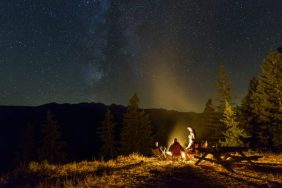Photo: Papakente, a Ndyuka gold miner, shows off his rings. Chinese market in front of Grand Santi, Suriname. © Nicola Lo Calzo/L’agence à paris.
Nicola Lo Calzo has dedicated himself to Cham, a long-term photographic project exploring the living memories of colonial slavery and anti-slavery struggles around the world. From this larger undertaking, Lo Calzo has just released Obia (Kehrer Verlag), a powerful study of the Maroon peoples of Suriname and French Guiana.

Maroons (from the Latin American Spanish word cimarrón: “feral animal, fugitive, runaway”) were African refugees who escaped from slavery in the Americas and formed independent settlements on both continents. The Maroon people of Dutch Guiana (now Suriname) escaped plantations and settled in the forests, surviving against the odds. They defended themselves against armed troops sent by the government, defying colonial order and the system of slavery. Maroons who were captured suffered dire consequences, yet despite the repression, the Maroon communities retained their sovereignty and signed their first treaty in 1760.
The history of the Maroon peoples remains one hidden from public view, yet they flourished across the Americas with communities in Louisiana, Jamaica, Cuba, Haiti, Colombia, and Brazil. The word Obia is originally an Akan word, specifically attributed to the Fanti, and points to a belief system of the Maroon peoples since their arrival from West Africa. With Obia, Lo Calzo considers the relationship between the past and the present, exploring the magical-religious legacy of the culture and the new challenges that stem from modernity.

Banai Meklien, from Kourou in French Guiana, with a parrot, participant in Gaama’s funeral in Asindoopo, Suriname. © Nicola Lo Calzo/L’agence à paris.
A process of “creolization” began at the end of the eighteenth century, continuing into the first half of the twentieth century, when contact was established between gold prospectors and the Maroon peoples, known collectively in the areas as Bushinengue. As time progressed, efforts to nationalize them were created, spawning issues of inter-generational conflict, the loss of references, unemployment, and rural migration.
Yet, at the same time, the Bushinengue were able to combine and adapt their native African ideas to their current circumstances, so that their legacy continues across generations. Confronted by a global economy that wants to appropriate their lands, the Bushinengue continue to fight to preserve their sovereign lands. The Bushinengue never surrendered, and their independent status is a reminder of this. They never broke with their origins and never embraced assimilation.

Ndyuka Maroon girl shows off her Marilyn Monroe t-shirt. Maroon Day celebrations, October 10, 2014, Albina, Suriname. © Nicola Lo Calzo/L’agence à paris.
With Obia, Lo Calzo takes us into another world, one that many do not know. He takes us into a world that is vibrant and intense, mysterious as the spirits of heaven and earth. What we see are poems, metaphors, and allegories, giving us a sense of the light, color, and texture of the Bushinengue world. Lo Calzo’s photographs are a tremendous contribution to the history of the Maroon peoples and the triumph of the human spirit, reminding us that freedom must never be taken for granted.
Miss Rosen is a New York-based writer, curator, and brand strategist. There is nothing she adores so much as photography and books. A small part of her wishes she had a proper library, like in the game of Clue. Then she could blaze and write soliloquies to her in and out of print loves.








